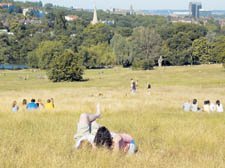|
|
 |
| |

Hampstead Heath has become a popular spot for north Londoners to relax – but the area’s past remains unknown to many of us
|
When the Heath had a duel purpose
Murder, suicide, and pistols at dawn all feature in a new book uncovering the secret history of the Heath, writes Dan Carrier
Hampstead Heath.
By Deborah Wolton and David McDowall.
Photographs by Sandra Lousada
Frances Lincoln £14.99.
DAWN, a frosty Christmas Eve morning, December 1839: leaf-less trees stand quiet against an overcast sky. The pair wait nervously on the fields of East Heath.
From Parliament Hill arrive their foes. Two men are here to settle a “debt of honour” and lay to rest an ongoing feud.
They walk the required 10 paces, turn and discharge their weapons.
Whether it is the early hour, combined with too much to drink the night before when the shootout was organised, or that they were simply bad shots, is not known.
But neither suffered an injury and their seconds negotiated a truce, upon which the foursome retired to a Hampstead inn, ate a hearty breakfast and drank a toast to non-violence.
Such tales are part and parcel of the history of Hampstead Heath, and are retold in a new book that tries to quantify what makes the Heath so special to so many different people.
As well as covering the fauna and flora of the area, it tells the social history of the Heath – murder, suicide and infanticide – while other morbid activities have been hinted at: when the Men’s Pond was drained and dredged, a number of handguns and knives were recovered.
Thankfully, the book chronicles less dangerous pursuits, including donkey rides. They were so popular that Charles Dickens dubbed the beasts “indigenous” to the Heath.
More obscure sports include the time in 1950 when a ski-jumping competition attracted huge crowds to Parliament Hill.
And as author Deborah Wolton points out: “One of the most remarkable characteristics of the Heath is that almost anything done on it will cause a splutter of outrage in some quarter. One-hundred-and-twenty-five years ago it was still commonplace everywhere in England for men to swim naked, not least in the upper Hampstead pond, which had been used for swimming since the 1820s, if not earlier. “But with public ownership of the Heath, the prudes went on the offensive.
“In July 1872 one of them being moved to write to The Times:
“At six o’clock last Sunday, taking a walk on this Heath, I have been more shocked and disgusted than I can find the words to express. Imagine, if you can, a...few ladies and gentlemen, numbers of children, and a hundred or so of the public strolling near the ponds, and some 50 perfectly naked men and boys bathing in the pond and running about the banks among the bystanders in a state of absolute nudity...”
Full of colour photographs by Sandra Lousada, the book is full of other, similar tales. Sadly, though, there is no evidence that the body of Queen Boadicea lies under the mound of pines up by what used to be Pitch Number Nine, and the hillock is not a burial barrow for the ancient Briton, but instead the remnants of a windmill.
Deborah Wolton is a landscape historian, and uses her expertise to reveal the hidden history. What this book really does is scrape away the surface of the Heath, the bits we all know well, and reveal the hidden history, the geology of what lies beneath, and how it has changed over the centuries. As Mrs Wolton and her co-author, guide writer David McDowall, point out: “Many of us who live within a stone’s throw of the Heath know it like the back of our hand. We routinely walk there. Or perhaps we explored it as children. And we are sure we know it, every inch. Or do we? Most of us have a tendency to walk the same routes, and look at the same things. In thinking we know the Heath intimately, it is easy to miss some of the less obvious delights.
“Few think of the Heath as wild, but then there is virtually no English countryside that is wild in a true sense either. Think of the Yorkshire Dales or the Lake District – man’s controlling hand is very evident in a landscape carefully maintained by grazing.
“Those who have rambled the Heath for over 50 years will know how much more overgrown and feral that it is now, despite being heavily trampled by Londoners, than it was in say, 1950.”
And it makes the reader realise why we should be thankful each time we wander across the slopes. It tells the story of how the areas was saved from development. Sir Thomas Maryon Wilson, the absentee landlord, tried to clear the way to sell his lands by putting before Parliament a Private Member’s Bill in 1829.
But local opposition was strong and well organised, and he only succeeded in exploiting the natural resources in Sandy Heath, carting away tonnes of sand, leaving a landscape of dips, valleys and ridges that today are exploited by young boys, breaking by-laws on BMX bikes, and using the area for brick-making.
His wish to exploit the land for houses was thankfully thwarted and after his death in 1869, his brother sold the common land to the Metropolitan Board of Works. Backed by a Bill in 1871, the Heath was saved forever.

|
 |
|
 |
 |
|
 |
|



